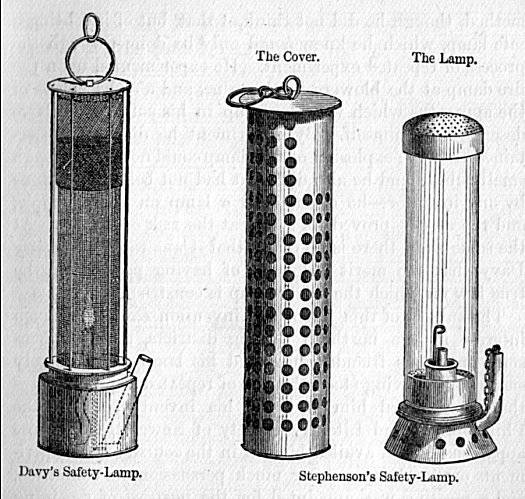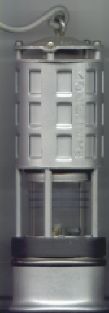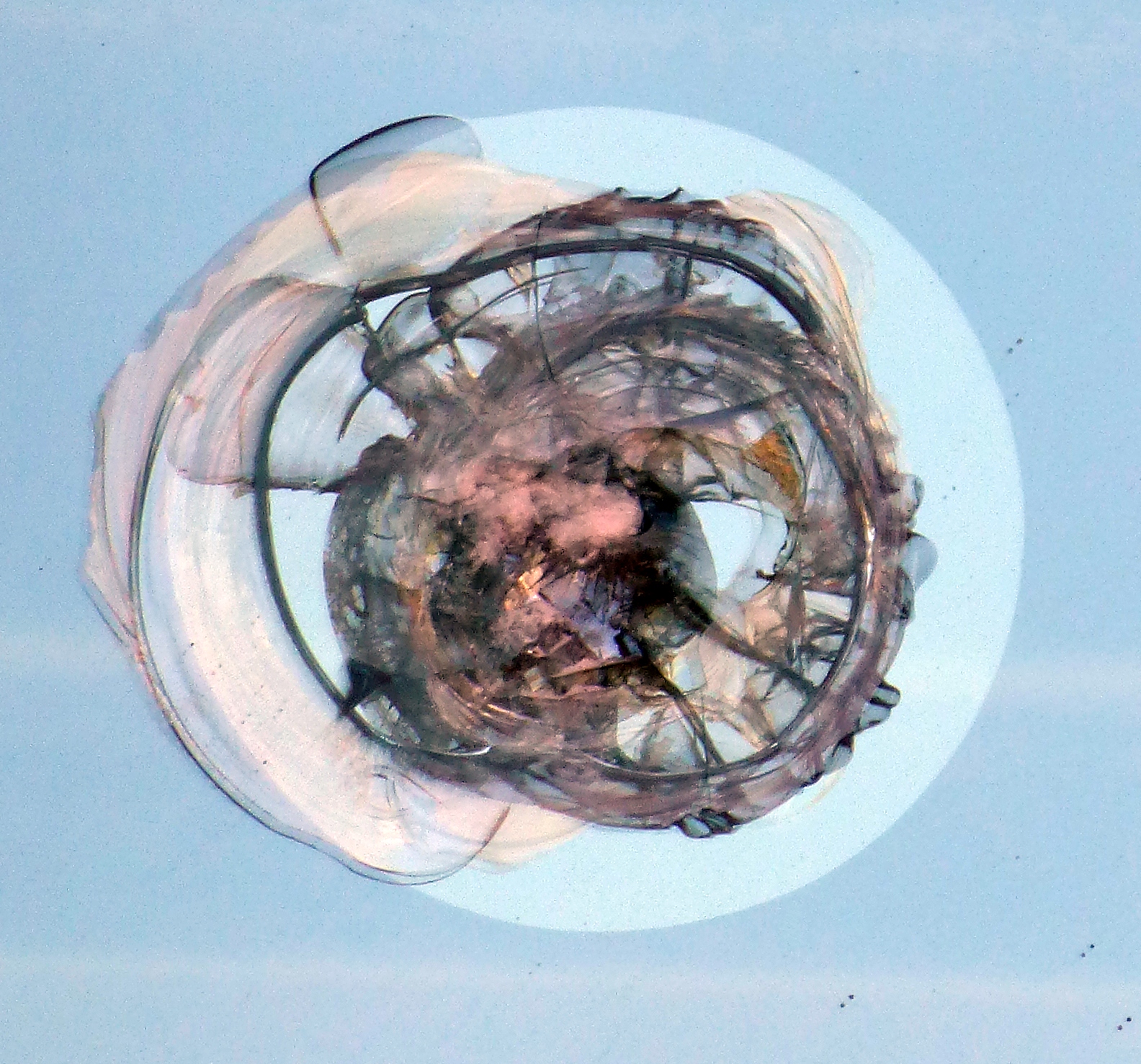|
Geordie Lamp
The Geordie lamp was a safety lamp for use in flammable atmospheres, invented by George Stephenson in 1815 as a miner's lamp to prevent explosions due to firedamp in coal mines. Origin In 1815, Stephenson was the engine-wright at the Killingworth Colliery in Northumberland and had been experimenting for several years with candles close to firedamp emissions in the mine. In August he ordered an oil lamp which was delivered on 21 October and tested by him in the mine in the presence of explosive gases. He improved this over several weeks with the addition of capillary tubes at the base so that it gave more light and tried new versions on 4 and 30 November. This was presented to the Literary and Philosophical Society (Lit & Phil) of Newcastle upon Tyne on 5 December 1815. Although controversy arose between Stephenson's design and the Davy lamp (invented by Humphry Davy in the same year), Stephenson's original design worked on significantly different principles from Davy's final d ... [...More Info...] [...Related Items...] OR: [Wikipedia] [Google] [Baidu] |
Barnsley
Barnsley () is a market town in South Yorkshire, England. As the main settlement of the Metropolitan Borough of Barnsley and the fourth largest settlement in South Yorkshire. In Barnsley, the population was 96,888 while the wider Borough has seen an increase of 5.8%, from 231,200 in 2011 census to 244,600 in 2021 census. Historically in the West Riding of Yorkshire, it is located between the cities of Sheffield, Manchester, Doncaster, Wakefield, and Leeds. The larger towns of Rotherham and Huddersfield are nearby. Barnsley's former industries include linen, coal mining, glassmaking and textiles. These declined in the 20th century, but Barnsley's culture is rooted in its industrial heritage and it has a tradition of brass bands, originally created as social clubs by its mining communities. The town is near to the M1 motorway and is served by Barnsley Interchange railway station on the Hallam and Penistone Lines. Barnsley has competed in the second tier of English footbal ... [...More Info...] [...Related Items...] OR: [Wikipedia] [Google] [Baidu] |
Oil Lamp
An oil lamp is a lamp used to produce light continuously for a period of time using an oil-based fuel source. The use of oil lamps began thousands of years ago and continues to this day, although their use is less common in modern times. They work in the same way as a candle but with fuel that is liquid at room temperature, so that a container for the oil is required. A textile wick drops down into the oil, and is lit at the end, burning the oil as it is drawn up the wick. Oil lamps are a form of lighting, and were used as an alternative to candles before the use of electric lights. Starting in 1780, the Argand lamp quickly replaced other oil lamps still in their basic ancient form. These in turn were replaced by the kerosene lamp in about 1850. In small towns and rural areas the latter continued in use well into the 20th century, until such areas were finally electrified and light bulbs could be used. Sources of fuel for oil lamps include a wide variety of plants such as n ... [...More Info...] [...Related Items...] OR: [Wikipedia] [Google] [Baidu] |
History Of Coal Mining
The history of coal mining goes back thousands of years, with early mines documented in ancient China, the Roman Empire and other early historical economies. It became important in the Industrial Revolution of the 19th and 20th centuries, when it was primarily used to power steam engines, heat buildings and generate electricity. Coal mining continues as an important economic activity today, but has begun to decline due to the strong contribution coal plays in global warming and environmental issues, which result in decreasing demand and in some geographies, peak coal. Compared to wood fuels, coal yields a higher amount of energy per unit mass, specific energy or massic energy, and can often be obtained in areas where wood is not readily available. Though it was used historically as a domestic fuel, coal is now used mostly in industry, especially in smelting and alloy production, as well as electricity generation. Large-scale coal mining developed during the Industrial Revolution, an ... [...More Info...] [...Related Items...] OR: [Wikipedia] [Google] [Baidu] |
English Inventions
English inventions and discoveries are objects, processes or techniques invented, innovated or discovered, partially or entirely, in England by a person from England. Often, things discovered for the first time are also called inventions and in many cases, there is no clear line between the two. Nonetheless, science and technology in England continued to develop rapidly in absolute terms. Furthermore, according to a Japanese research firm, over 40% of the world's inventions and discoveries were made in the UK, followed by France with 24% of the world's inventions and discoveries made in France and followed by the US with 20%. The following is a list of inventions, innovations or discoveries known or generally recognised to be English. Agriculture * 1627: Publication of first experiments in Water desalination and filtration by Sir Francis Bacon (1561–1626). * 1701: Seed drill improved by Jethro Tull (1674–1741). *18th century: of the horse-drawn hoe and scarifier by Je ... [...More Info...] [...Related Items...] OR: [Wikipedia] [Google] [Baidu] |
Wheat Lamp
A wheat lamp is a type of incandescent light designed for use in underground mining, named for inventor Grant Wheat and manufactured by Koehler Lighting Products in Wilkes-Barre, Pennsylvania, United States, a region known for extensive mining activity. A safety lamp designed for use in potentially hazardous atmospheres such as firedamp and coal dust, the lamp is mounted on the front of the miner's helmet and powered by a wet cell battery worn on the miner's belt. The average wheat lamp uses a three to five watt bulb which will typically operate for five to 16 hours depending on the amp-hour capacity of the battery and the current draw of the bulb being used.L. C. Isley, A. B. Hooker, ''Permissible Electric Mine Lamps'', US Department of Commerce Bulletin No. 332, 1930, pp. 32-34 A grain-of-wheat lamp is an unrelated, very small incandescent lamp used in medical and optical instruments, as well as for illuminating miniature railroad Railway modelling (UK, Australia, ... [...More Info...] [...Related Items...] OR: [Wikipedia] [Google] [Baidu] |
Safety Lamp
A safety lamp is any of several types of lamp that provides illumination in coal mines and is designed to operate in air that may contain coal dust or gases, both of which are potentially flammable or explosive. Until the development of effective electric lamps in the early 1900s, miners used flame lamps to provide illumination. Open flame lamps could ignite flammable gases which collected in mines, causing explosions; safety lamps were developed to enclose the flame and prevent it from igniting the surrounding atmosphere. Flame safety lamps have been replaced in mining with sealed explosion-proof electric lights. Background Damps or gases Miners have traditionally referred to the various gases encountered during mining as damps, from the Middle Low German word ''dampf'' (meaning "vapour"). Damps are variable mixtures and are historic terms. * ''Firedamp'' Naturally occurring flammable mixtures, principally methane. * ''Blackdamp'' or ''Chokedamp'' Nitrogen and carbon dioxide ... [...More Info...] [...Related Items...] OR: [Wikipedia] [Google] [Baidu] |
List Of Light Sources
This is a list of sources of light, the visible part of the electromagnetic spectrum. Light sources produce photons from another energy source, such as heat, chemical reactions, or conversion of mass or a different frequency of electromagnetic energy, and include light bulbs and stars like the Sun. Reflectors (such as the moon, cat's eyes, and mirrors) do not actually produce the light that comes from them. Incandescence Incandescence is the emission of light from a hot body as a result of its temperature. * * Combustion Lamps * (obsolete) * * * * (error) * * * * *s *s * (obsolete) *s * Other * * * *s * * * * * * * * * Nuclear and high-energy particle * * ** ** * * * * * Celestial and atmospheric *Astronomical objects **Sun (sunlight, solar radiation) *** *** **Star (Starlight) ***Nova / supernova / hypernova *** **** *** ** *** *** *** *** *** * **Meteor *** ** *** *Lightning (Plasma) ** ** ** ** * * Luminescence Luminescence is emissio ... [...More Info...] [...Related Items...] OR: [Wikipedia] [Google] [Baidu] |
Tracts Vol 19 P35 George Stephenson's Safety Lamp
Tract may refer to: Geography and real estate * Housing tract, an area of land that is subdivided into smaller individual lots * Land lot or tract, a section of land * Census tract, a geographic region defined for the purpose of taking a census Writings * Tract (literature), a short written work, usually of a political or religious nature * Tract (liturgy), a component of Roman Catholic liturgy * Treatise Biology * Nerve tract, a bundle of fibers that connects different parts of the central nervous system - analogous to a nerve in the peripheral nervous system * A genetic tract, a sequence of repeating nucleotides or amino acids, such as a polyglutamine tract * A collection of related anatomic structures, such as: ** Gastrointestinal tract ** Genitourinary tract ** Reproductive tract ** A grouping of feathers, e.g. primaries, auricular, scapular Businesses * Tract (imprint), an imprint of the German group VDM Publishing devoted to the reproduction of Wikipedia content See a ... [...More Info...] [...Related Items...] OR: [Wikipedia] [Google] [Baidu] |
Tracts Vol 19 P32-33 George Stephenson's Safety Lamp
Tract may refer to: Geography and real estate * Housing tract, an area of land that is subdivided into smaller individual lots * Land lot or tract, a section of land * Census tract, a geographic region defined for the purpose of taking a census Writings * Tract (literature), a short written work, usually of a political or religious nature * Tract (liturgy), a component of Roman Catholic liturgy * Treatise Biology * Nerve tract, a bundle of fibers that connects different parts of the central nervous system - analogous to a nerve in the peripheral nervous system * A genetic tract, a sequence of repeating nucleotides or amino acids, such as a polyglutamine tract * A collection of related anatomic structures, such as: ** Gastrointestinal tract ** Genitourinary tract ** Reproductive tract ** A grouping of feathers, e.g. primaries, auricular, scapular Businesses * Tract (imprint), an imprint of the German group VDM Publishing devoted to the reproduction of Wikipedia content See a ... [...More Info...] [...Related Items...] OR: [Wikipedia] [Google] [Baidu] |
Safety Glass
Safety glass is glass with additional safety features that make it less likely to break, or less likely to pose a threat when broken. Common designs include toughened glass (also known as tempered glass), laminated glass, and wire mesh glass (also known as wired glass). Wire mesh glass was invented by Frank Shuman. Laminated glass was invented in 1903 by the French chemist Édouard Bénédictus (1878–1930). These three approaches can easily be combined, allowing for the creation of glass that is at the same time toughened, laminated, and contains a wire mesh. However, combination of a wire mesh with other techniques is unusual, as it typically betrays their individual qualities. In many developed countries safety glass is part of the building regulations making properties safer. Toughened glass Toughened glass is processed by controlled thermal or chemical treatments to increase its strength compared with normal glass. Tempering, by design, creates balanced internal stre ... [...More Info...] [...Related Items...] OR: [Wikipedia] [Google] [Baidu] |
Oaks Explosion
The Oaks explosion, which happened at a coal mine in West Riding of Yorkshire on 12 December 1866, remains the worst mining accident, mining disaster in England. A series of explosions caused by firedamp ripped through the underground workings at the Oaks Colliery at Hoyle Mill near Stairfoot in Barnsley killing 361 miners and rescuers. It was the worst mining disaster in the United Kingdom until the 1913 Senghenydd colliery disaster, Senghenydd explosion in Wales. Oaks Colliery The first shaft at the Oaks Colliery was sunk in the early 1830s. In 1845 two separate explosions occurred at the Coal mining, colliery. On both occasions few men were below ground and no more than three or four workers died. Two years later a more serious incident occurred after firedamp, which had accumulated in old workings, was ignited and exploded. Of the men underground, 73 were killed and 26 were rescued. Changes were then made to the colliery's Underground mine ventilation, ventilation. The d ... [...More Info...] [...Related Items...] OR: [Wikipedia] [Google] [Baidu] |




.jpg)



